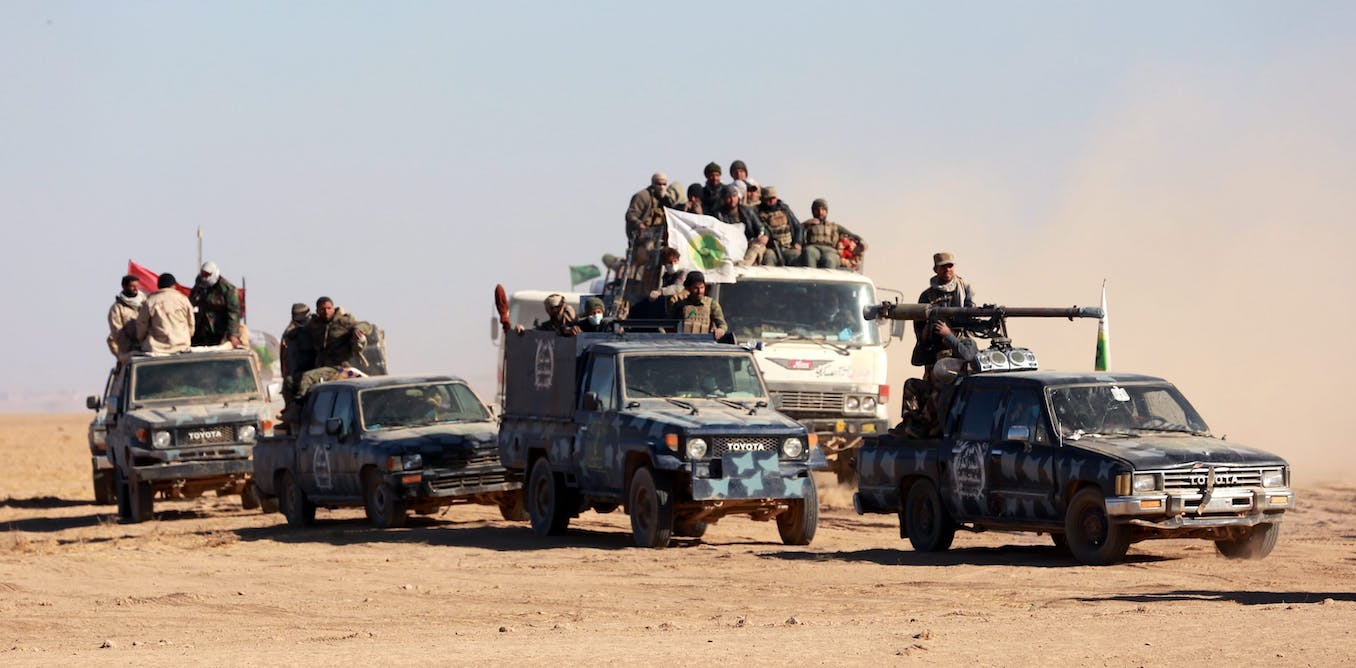Almost a decade ago, the Sunni jihadist network known as the Islamic State (IS) declared the formation of an Islamic Caliphate after they captured the Iraqi city of Mosul in June 2014.
In response, tens of thousands of Shia men joined a complex patchwork of militias to fight against IS. Many of these militias are notoriously violent and directly loyal to Iran’s theocratic state.
But very little is known about how these Shia militias were so quickly and so effectively mobilised. In our research, we have taken a novel approach, examining the many popular music videos produced by these militias.
These music videos drew on a complex cocktail of historical myths and contemporary clergymen to mobilise Iraq’s Shia population to fight the IS.
Understanding Islamic State: where does it come from and what does it want?
Foundational myths, historical grievances
The popular music videos explicitly reference a deeply held set of religious myths and symbols that have informed Shia politics since its inception.
One video shows images of militiamen driving towards the front-lines and firing from a bunker at IS targets.
The singer extols the religious virtues of fighting the IS by comparing those killed today with the Shia martyrs at the Battle of Karbala:
We fight our enemies. Our martyrs are similar to the martyrs of Karbala. Our people are supporters of Hussein.
The divide between the Sunni and Shia sects dates back to the early years of Islam.
A debate emerged after the Prophet Muhammad’s death about who should lead the Islamic community. The majority accepted the authority of the Prophet’s senior companion, Abu Bakr. A minority, later identified as Shiites, believed only a blood relative of the Prophet – in particular, his cousin Ali – had the right to lead.
In the year 680, the division between the two sects escalated at the Battle of Karbala, where Ali’s son Hussein and many of his followers were defeated and executed by Sunni forces.
The legend of the Battle of Karbala has come to symbolise the historical injustice of the Shia faithful at the hands of the Sunni majority. It is commemorated at the annual Ashura festival in which Shiites reenact the battle, including by self-flagellation.
The emotive lyrics and tone of the song are specifically designed to resonate with this history of suffering.
What is the Shia-Sunni divide?
The Shia jihad against the IS
The popular music videos produced by different Shia militias also draw on fatwas (religious edicts) issued by several prominent Shia clerics in response to the violence of the IS.
In 2014, Iraq’s most senior Shia cleric Grand Ayatollah Sistani issued a fatwa announcing a jihad (holy war) against the IS.
He called for a mass Shia mobilisation, arguing
It is the legal and national responsibility of whoever can hold a weapon to take up arms to defend the country, the citizens and the holy sites.
Some popular music videos explicitly cite the fatwas of Sistani and other clerics, encouraging their young supporters to heed these calls. A short clip shows armed members of one militia chanting: “Al-Sistani is like a crown on our heads. Your wish is our command.”
One very slickly produced music video refers to both historical grievances over the failure to recognise Ali as the legitimate heir of the Prophet Muhammad and to the centrality of Sistani’s fatwa to their decision to fight the IS:
We are the Turkmen [of Iraq]
We follow Ali’s path
Iraq must live in peace and happiness
When Sistani orders us, we obey. We will defeat and destroy the IS
We believe in the fatwas of our religious authorities, and we defend our holy sites.
As the singer recites each verse, the footage shows heavily armed Shia men posing in front of a tank. It also features live action footage from various battles against the IS, including advancing on key targets, firing machine guns and heavy artillery.
Mobilising young men
These videos serve as a unique archive of the war against the IS, demonstrating the ways in which these militias found novel ways to mobilise young men to fight by drawing on a rich catalogue of Shia religious symbolism as well as the fatwas of clerics like Sistani.
Slick popular music videos draw on a rich catalogue of historical motifs of suffering as well as the contemporary edicts of key clergymen, produced by different Shia militias and shared on YouTube and other social media platforms.
These evocative and poignant songs played an underappreciated and under-examined part in mobilising young men to fight back against the horrors of the IS, indicating the powerful role popular culture plays in contemporary warfare.
The Islamic State flag hijacks Muslim words of faith. Banning it could cause confusion and unfair targeting of Muslims




